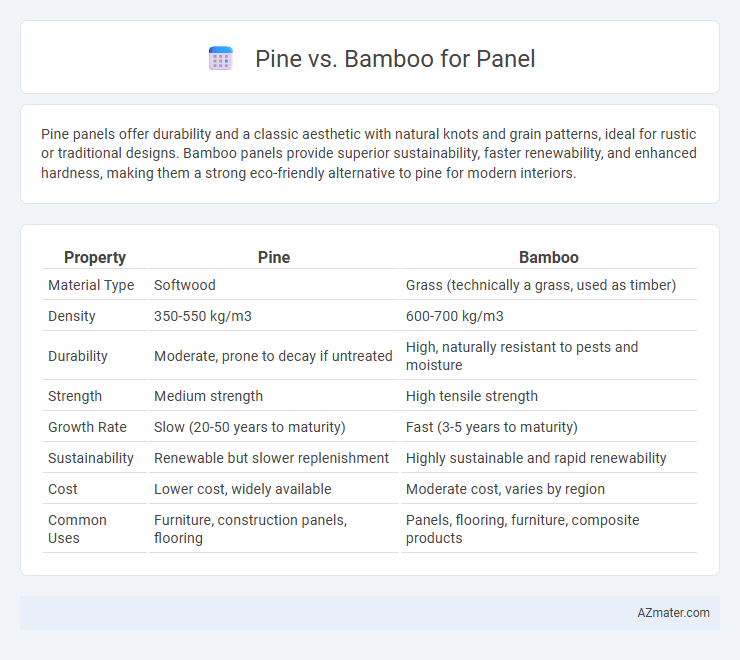Pine panels offer durability and a classic aesthetic with natural knots and grain patterns, ideal for rustic or traditional designs. Bamboo panels provide superior sustainability, faster renewability, and enhanced hardness, making them a strong eco-friendly alternative to pine for modern interiors.
Table of Comparison
| Property | Pine | Bamboo |
|---|---|---|
| Material Type | Softwood | Grass (technically a grass, used as timber) |
| Density | 350-550 kg/m3 | 600-700 kg/m3 |
| Durability | Moderate, prone to decay if untreated | High, naturally resistant to pests and moisture |
| Strength | Medium strength | High tensile strength |
| Growth Rate | Slow (20-50 years to maturity) | Fast (3-5 years to maturity) |
| Sustainability | Renewable but slower replenishment | Highly sustainable and rapid renewability |
| Cost | Lower cost, widely available | Moderate cost, varies by region |
| Common Uses | Furniture, construction panels, flooring | Panels, flooring, furniture, composite products |
Introduction: Pine vs Bamboo for Panel Applications
Pine and bamboo are popular materials for panel applications, each offering unique structural and aesthetic benefits. Pine panels are prized for their durability, consistent grain, and ease of staining, making them suitable for furniture and interior walls. Bamboo panels provide exceptional sustainability, rapid growth, and high tensile strength, offering an eco-friendly alternative with a distinct natural look for modern paneling projects.
Material Overview: Characteristics of Pine Panels
Pine panels are valued for their lightweight nature, fine straight grain, and pale yellow to light brown color, making them ideal for interior applications and furniture. The softwood is easy to work with, offers good nail and screw retention, and exhibits moderate durability but requires proper treatment for enhanced resistance to decay and insects. Pine's affordability and availability make it a popular choice, although it is prone to dents and scratches compared to harder woods like bamboo.
Material Overview: Characteristics of Bamboo Panels
Bamboo panels exhibit exceptional strength and flexibility due to their natural fibrous structure, making them highly durable compared to traditional wood panels like pine. They offer superior resistance to moisture and pests, contributing to longer lifespan and reduced maintenance requirements. Bamboo's rapid growth rate and eco-friendly harvesting process position it as a sustainable alternative for panel materials in construction and furniture applications.
Sustainability and Environmental Impact
Pine panels are derived from fast-growing softwood trees that sequester carbon efficiently, but their production often involves intensive logging practices that can impact biodiversity. Bamboo panels offer superior sustainability due to bamboo's rapid growth rate--up to 3 feet per day--and its ability to regenerate without replanting, resulting in minimal soil erosion and reduced carbon footprint. Bamboo's high strength-to-weight ratio combined with lower reliance on chemical treatments further enhances its environmental benefits compared to conventional pine panels.
Strength and Durability Comparison
Bamboo panels offer superior tensile strength and natural resistance to moisture and insects, making them highly durable for construction and furniture applications. Pine panels, while easier to work with and more cost-effective, tend to be softer and less resistant to wear and environmental factors over time. Bamboo's dense fiber structure provides enhanced longevity compared to the relatively porous and softer composition of pine wood.
Aesthetic Differences: Texture, Grain, and Color
Pine panels typically feature a soft texture with prominent knots and straight grain patterns, offering a rustic and warm aesthetic characterized by light yellow to pale brown hues. Bamboo panels present a smooth, uniform texture with fine, linear grain lines and a consistent color palette ranging from light tan to rich golden tones, providing a modern and sleek appearance. The distinct grain structure and color variations between pine and bamboo significantly influence their visual appeal, making pine ideal for traditional or country styles and bamboo suited for contemporary or minimalist designs.
Cost Analysis: Pine vs Bamboo Panels
Pine panels generally offer a lower upfront cost compared to bamboo panels due to the faster growth cycle and abundant supply of pine trees. Bamboo panels, while often more expensive, provide superior durability and environmental benefits, potentially reducing long-term replacement and maintenance expenses. Cost analysis must consider initial price, lifespan, and sustainability factors to determine overall value between pine and bamboo panel options.
Ease of Installation and Workability
Pine panels offer ease of installation due to their lightweight nature and uniform grain, allowing for smooth cutting and fastening with standard tools. Bamboo panels, while slightly harder and denser, provide excellent workability but may require sharper blades or specialized equipment to avoid splintering. Both materials support efficient installation, but pine's softer texture typically results in quicker handling and less tool wear.
Maintenance and Longevity Factors
Pine panels require regular sealing and treatment to prevent moisture damage and insect infestation, impacting long-term maintenance efforts. Bamboo panels, known for their natural resistance to pests and moisture, offer superior durability with less frequent upkeep, extending their lifespan significantly. Choosing bamboo can reduce maintenance costs and enhance panel longevity, making it a sustainable option for long-term use.
Best Uses: Choosing the Right Panel for Your Project
Pine panels offer excellent durability and a warm, natural aesthetic ideal for interior walls, cabinetry, and furniture, making them suitable for projects requiring cost-effective, sturdy wood. Bamboo panels provide superior sustainability, moisture resistance, and a modern appearance, perfect for eco-friendly designs, flooring, and high-humidity areas. Selecting the right panel depends on your project's needs for durability, environmental impact, and style preferences.

Infographic: Pine vs Bamboo for Panel
 azmater.com
azmater.com